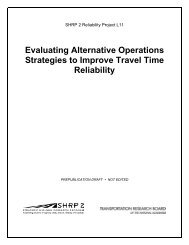Contemporary Approaches to Parking Pricing: - FHWA Operations
Contemporary Approaches to Parking Pricing: - FHWA Operations
Contemporary Approaches to Parking Pricing: - FHWA Operations
You also want an ePaper? Increase the reach of your titles
YUMPU automatically turns print PDFs into web optimized ePapers that Google loves.
Multi-space Meters<br />
The multi-space meter classification represents a broad assortment of payment and technology options. Multispace<br />
meters are common with both on-street and off-street facilities and can support pay and display, pay by space,<br />
and pay by license plate. While each of these has unique benefits and applications, all are capable of accepting coin<br />
and credit card payments, real-time reporting, and dynamic pricing while reducing the clutter associated with<br />
single-space meters. Specific options associated with multi-space meters are summarized below:<br />
• Pay and display requires users <strong>to</strong> walk <strong>to</strong> a central pay station, make their payment, and place a receipt on their vehicle’s<br />
dashboard. This option allows enforcement personnel <strong>to</strong> determine quickly if a vehicle is in violation of time<br />
limits and, as long as time remains on users’ receipts, they can move within a parking district without making additional<br />
payments. A disadvantage is that users may find it inconvenient <strong>to</strong> return <strong>to</strong> their vehicles after paying.<br />
Also, if a pay-and-display station is out of service, multiple parking spaces are affected, resulting in lost revenue.<br />
• Pay by space functions similarly <strong>to</strong> pay and display, but rather than placing a receipt on their dashboard, users enter<br />
a space number associated with their parking space. Complaints are reduced because users do not need <strong>to</strong> return <strong>to</strong><br />
their vehicle, but enforcement personnel must pull reports <strong>to</strong> determine which occupied spaces may be in violation<br />
of time limits, which can slow enforcement processes. It is possible <strong>to</strong> integrate this payment system with space<br />
sensors, discussed below, <strong>to</strong> simplify the enforcement process. Pay by space removes the option that allows users<br />
who still have parking time remaining <strong>to</strong> move <strong>to</strong> another space within a parking district without paying again. As<br />
with pay and display, an out-of-service station will affect numerous parking spaces.<br />
• Pay by license plate is very similar <strong>to</strong> pay by space; however, rather than entering a space number, users enter their<br />
license plate number. The primary drawback is that some users do not know their license plate number or might<br />
key it in wrong. As with pay and display, this option allows users with parking time remaining <strong>to</strong> travel within a<br />
parking district without paying additional fees.<br />
In-car Meters<br />
In-car meters are small, programmable devices that hang from rearview mirrors and driver’s side grab bars (handles<br />
located above the driver’s side window) or are placed on dashboards. The meters are pre-loaded with funds that are<br />
deducted based on the location of a vehicle and duration that it is parked. When users arrive at a parking space they<br />
select the appropriate parking zone, which tells the meter what parking rate <strong>to</strong> charge, and activate a timer that<br />
deducts funds from the user’s account based on the time the vehicle is parked.<br />
Reusable and disposable versions of in-car meters are available, and funds can be added over the phone, on the<br />
Internet, or using smart cards that are inserted in<strong>to</strong> the devices. Some in-car meters contain Global Positioning<br />
System (GPS) cards that allow the meters <strong>to</strong> determine their location and au<strong>to</strong>matically charge the appropriate rate.<br />
Efforts are currently underway <strong>to</strong> integrate in-car meters in<strong>to</strong> vehicle navigation systems, such as OnStar. In-car<br />
meters offer an alternative <strong>to</strong> single-space and multi-space meters but do not typically replace those meters.<br />
In-car meters allow users <strong>to</strong> pay only for the time they use, reduce the threat of vandalism, and yield higher levels of<br />
compliance. Because money is loaded on<strong>to</strong> the meters before use, parking departments have the dual benefits of<br />
receiving revenue up front while reducing collection costs. The ability <strong>to</strong> pay in the vehicle allows users <strong>to</strong> avoid<br />
standing outside <strong>to</strong> pay at single-space meters or walking <strong>to</strong> multi-space meters. Unlike multi-space and smart meters,<br />
however, in-car meters do not provide real-time information <strong>to</strong> parking managers. Some parking agencies have<br />
also expressed the concern that visibly placed in-car meters are subject <strong>to</strong> theft.<br />
C o n t e m p o r a r y A p p r o a c h e s t o P a r k i n g P r i c i n g | 9















